Introduction
As cities worldwide grapple with the impacts of climate change, urban greening has emerged as a critical strategy for climate adaptation and resilience. Urban greening involves integrating green infrastructure—such as parks, street trees, green roofs, and gardens—into urban landscapes to mitigate the adverse effects of climate change while enhancing ecological health and community well-being. This approach offers a holistic solution, addressing environmental, social, and economic challenges associated with urban living. This article explores the importance of urban greening in climate adaptation and outlines key strategies for implementing effective urban greening initiatives.
The Role of Urban Greening in Climate Adaptation
Urban greening plays a multifaceted role in climate adaptation, offering ecological, social, and economic benefits. Green spaces and vegetation help mitigate urban heat island effects by absorbing heat, providing shade, and enhancing evapotranspiration, thereby cooling urban areas (Bowler et al., 2010). This cooling effect is crucial for reducing heat-related health risks, improving thermal comfort for residents, and curbing energy consumption for air conditioning.
Moreover, urban greening improves air quality by filtering pollutants and capturing carbon dioxide, contributing to emissions reduction goals (Nowak et al., 2006). Green infrastructure also enhances urban biodiversity, providing habitat for wildlife and supporting pollinators essential for ecosystem health. Additionally, green spaces promote flood mitigation by improving soil permeability and water retention, reducing stormwater runoff, and mitigating flood risk (Kazmierczak & Carter, 2010).
Integrating Green Infrastructure
A fundamental strategy for urban greening involves integrating green infrastructure into urban planning and development. This integration requires a systematic approach, incorporating green elements within residential, commercial, and industrial areas. Key components include:
- Parks and Natural Reserves: Establishing and maintaining public parks and natural reserves within cities offers residents access to natural environments, promoting recreation, mental well-being, and community engagement. These areas serve as essential lungs for cities, supporting biodiversity and enhancing ecological networks (Beatley, 2011).
- Street Trees and Urban Forests: Planting street trees and developing urban forests improve urban aesthetics, increase shade coverage, and enhance air quality. Trees along streets and in public areas act as windbreaks, reduce noise pollution, and provide cooling effects that mitigate heat stress (Konijnendijk et al., 2005).
- Green Roofs and Walls: Implementing green roofs and vertical gardens on buildings enhances insulation, reduces energy demands, and improves air quality. Green roofs capture rainwater, reducing stormwater runoff and lowering the risk of urban flooding (Oberndorfer et al., 2007).
Community Engagement and Participation
Successful urban greening initiatives require active community engagement and participation. Involving local residents in planning and implementing greening projects fosters a sense of ownership and stewardship, ensuring long-term maintenance and sustainability (Kim & Kaplan, 2004). Community-driven initiatives, such as community gardens and tree-planting programs, empower individuals to contribute to environmental conservation and foster social cohesion.
Urban planners and policymakers should prioritize inclusive planning processes, incorporating diverse community perspectives and needs into greening strategies. Education and awareness campaigns can increase public understanding of the benefits of urban greening, encouraging residents to support and participate in initiatives (Chiesura, 2004).
Leveraging Technology and Innovation
Technological advancements offer opportunities to enhance urban greening efforts. Utilizing geospatial analysis and remote sensing technologies enables planners to identify suitable sites for new green infrastructure, monitor vegetation health, and assess ecosystem services (Davies et al., 2011). Data-driven decision-making supports the strategic placement of green spaces, optimizing climate adaptation benefits.
Innovative solutions, such as smart irrigation systems and adaptive plant species selection, can further improve the resilience of green infrastructure to climate variability (Gill et al., 2007). By integrating technology with traditional green practices, cities can enhance the effectiveness and sustainability of urban greening efforts.
Conclusion
Urban greening serves as a pivotal strategy for climate adaptation, offering a comprehensive approach to mitigating the impacts of climate change while enhancing urban quality of life. By integrating green infrastructure, engaging communities, and leveraging technology, cities can develop sustainable greening strategies that promote resilience, health, and well-being. As urbanization and climate challenges continue to evolve, prioritizing urban greening within urban planning processes will be essential to creating thriving, adaptable cities capable of facing future uncertainties.
References
Beatley, T. (2011). Biophilic cities: Integrating nature into urban design and planning. Island Press.
Bowler, D. E., Buyung-Ali, L., Knight, T. M., & Pullin, A. S. (2010). Urban greening to cool towns and cities: A systematic review of the empirical evidence. Landscape and Urban Planning, 97(3), 147-155.
Chiesura, A. (2004). The role of urban parks for the sustainable city. Landscape and Urban Planning, 68(1), 129-138.
Davies, Z. G., Edmondson, J. L., Heinemeyer, A., Leake, J. R., & Gaston, K. J. (2011). Mapping an urban ecosystem service: Quantifying above‐ground carbon storage at a city‐wide scale. Journal of Applied Ecology, 48(5), 1125-1134.
Gill, S. E., Handley, J. F., Ennos, A. R., & Pauleit, S. (2007). Adapting cities for climate change: The role of the green infrastructure. Built Environment, 33(1), 115-133.
Kazmierczak, A., & Carter, J. (2010). Adaptation to climate change using green and blue infrastructure. The University of Manchester.
Kim, J. Y., & Kaplan, R. (2004). Physical and psychological benefits of neighborhoods parks. Journal of Architectural and Planning Research, 21(2), 216-231.
Konijnendijk, C. C., Ricard, R. M., Kenney, A., & Randrup, T. B. (2005). Defining urban forestry – A comparative perspective of North America and Europe. Urban Forestry & Urban Greening, 4(3-4), 93-103.
Nowak, D. J., Hirabayashi, S., Bodine, A., & Greenfield, E. (2006). Tree and forest effects on air quality and human health in the United States. Environmental Pollution, 193, 119-129.
Oberndorfer, E., Lundholm, J., Bass, B., Coffman, R. R., Doshi, H., Dunnett, N., … & Rowe, B. (2007). Green roofs as urban ecosystems: Ecological structures, functions, and services. BioScience, 57(10), 823-833.
Image: Oasis OT
